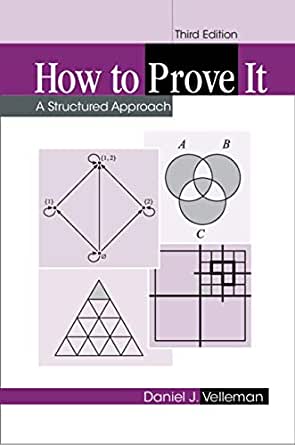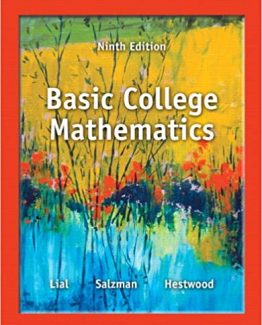How to Prove It: A Structured Approach 3rd Edition by Daniel J. Velleman, ISBN-13: 978-1108439534
[PDF eBook eTextbook]
- Publisher: Cambridge University Press; 3rd edition (August 29, 2019)
- Language: English
- 468 pages
- ISBN-10: 1108439535
- ISBN-13: 978-1108439534
Helps students transition from problem solving to proving theorems, with a new chapter on number theory and over 150 new exercises.
Proofs play a central role in advanced mathematics and theoretical computer science, yet many students struggle the first time they take a course in which proofs play a significant role. This bestselling text’s third edition helps students transition from solving problems to proving theorems by teaching them the techniques needed to read and write proofs. Featuring over 150 new exercises and a new chapter on number theory, this new edition introduces students to the world of advanced mathematics through the mastery of proofs. The book begins with the basic concepts of logic and set theory to familiarize students with the language of mathematics and how it is interpreted. These concepts are used as the basis for an analysis of techniques that can be used to build up complex proofs step by step, using detailed ‘scratch work’ sections to expose the machinery of proofs about numbers, sets, relations, and functions. Assuming no background beyond standard high school mathematics, this book will be useful to anyone interested in logic and proofs: computer scientists, philosophers, linguists, and, of course, mathematicians.
Table of Contents:
Preface to the Third Edition page ix
Introduction 1
1 Sentential Logic 8
1.1 Deductive Reasoning and Logical Connectives 8
1.2 Truth Tables 15
1.3 Variables and Sets 26
1.4 Operations on Sets 35
1.5 The Conditional and Biconditional Connectives 45
2 Quantificational Logic 58
2.1 Quantifiers 58
2.2 Equivalences Involving Quantifiers 68
2.3 More Operations on Sets 78
3 Proofs 89
3.1 Proof Strategies 89
3.2 Proofs Involving Negations and Conditionals 100
3.3 Proofs Involving Quantifiers 113
3.4 Proofs Involving Conjunctions and Biconditionals 130
3.5 Proofs Involving Disjunctions 142
3.6 Existence and Uniqueness Proofs 153
3.7 More Examples of Proofs 162
4 Relations 173
4.1 Ordered Pairs and Cartesian Products 173
4.2 Relations 182
4.3 More About Relations 191
4.4 Ordering Relations 200
4.5 Equivalence Relations 215
5 Functions 229
5.1 Functions 229
5.2 One-to-One and Onto 240
5.3 Inverses of Functions 249
5.4 Closures 259
5.5 Images and Inverse Images: A Research Project 268
6 Mathematical Induction 273
6.1 Proof by Mathematical Induction 273
6.2 More Examples 280
6.3 Recursion 293
6.4 Strong Induction 303
6.5 Closures Again 316
7 Number Theory 324
7.1 Greatest Common Divisors 324
7.2 Prime Factorization 332
7.3 Modular Arithmetic 341
7.4 Euler’s Theorem 351
7.5 Public-Key Cryptography 359
8 Infinite Sets 372
8.1 Equinumerous Sets 372
8.2 Countable and Uncountable Sets 382
8.3 The Cantor-Schr¨oder-Bernstein Theorem 389
Appendix: Solutions to Selected Exercises 397
Suggestions for Further Reading 451
Summary of Proof Techniques 453
Daniel J. Velleman is Julian H. Gibbs ’46 Professor of Mathematics, Emeritus at Amherst College, and was a professor at Amherst College from 1983 to 2017. He received his B.A. from Dartmouth College in 1976, and his Ph.D. from the University of Wisconsin, Madison in 1980. His other books include Which Way Did the Bicycle Go? (with Stan Wagon and Joe Konhauser, 1996), Philosophies of Mathematics (with Alexander George, 2002), and Calculus: A Rigorous First Course (2016). Among his awards and distinctions are the Chauvenet Prize, the Paul R. Halmos–Lester R. Ford Award, the Carl B. Allendoerfer Award, and the Chandler Davis Prize for Expository Excellence. He was Editor of Dolciani Mathematical Expositions from 1999 to 2004 and the American Mathematical Monthly from 2007 to 2011.
What makes us different?
• Instant Download
• Always Competitive Pricing
• 100% Privacy
• FREE Sample Available
• 24-7 LIVE Customer Support






Reviews
There are no reviews yet.